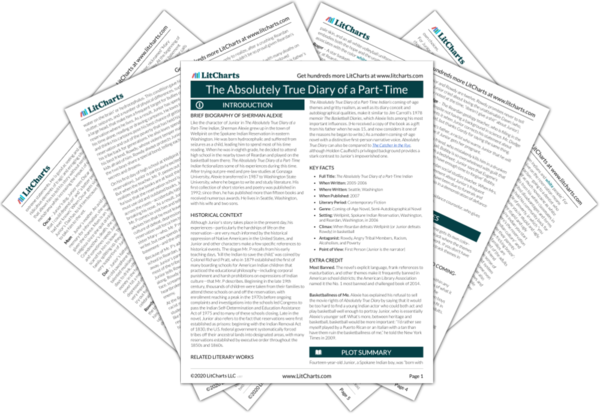Summary
Analysis
On his first day of high school, Junior is particularly excited about his first geometry class, confessing that isosceles triangles make him feel “hormonal.” Of course, women and their curves make him hormonal too. Junior confesses frankly that he can spend hours masturbating, and is not just unashamed, but proud to say he’s good at it “because EVERYBODY does it. And EVERYBODY likes it. And if God hadn’t wanted us to masturbate, then God wouldn’t have given us thumbs.”
Part of coming of age is exploring sexual desire and learning to be comfortable with it. Junior’s frank discussion of masturbation is not only funny, but also important, as a confession that establishes intimacy and trust between him and the reader.
Themes
Still, Junior is “much more in love with the right angles of buildings” than with any imaginary woman. As a child, he used to love to sleep in corners, and spent a few years sleeping in his bedroom closet until his older sister Mary ruined it by telling him he was just trying to find his way back into his mother’s womb.
Junior is beginning to have adult desires, but he hasn’t yet left his childhood behind. This passage shows the process of growing up, establishing Junior as halfway between childhood and adulthood, withMary’s “ruining” the closet as one of the disillusionments involved in growing up.
Themes
Junior says Mary is “good at ruining things.” Although Mary is beautiful, strong, and funny, she shut down after she finished high school for reasons no one in the family understands, and has been living alone in the family’s basement for the past seven years. Junior’s drawing of her shows her looking tough, “like Jennifer Lopez (if J. Lo was smarter)” and wearing clothes that have all been shoplifted or stolen. She is nicknamed “Mary Runs Away” because she is so unpredictable. Junior, in contrast, is “steady” and “excited about life.”
Like Rowdy, Mary is another one of the people against whom Junior defines himself. She is tough, but also downwardly mobile, two traits that Junior sees as opposite to himself. Junior loves, admires, and pities Mary at the same time. His cartoon of her doesn’t show her dreams, but her real self, which could suggest he doesn’t believe any dreams are possible for her anymore.
Themes
In particular, Junior is excited about school, particularly playing basketball with Rowdy on the high school team. They were the best players on their eighth-grade team last year. Because Rowdy is so much bigger and stronger, Junior is a little scared that Rowdy will outshine him, leave him behind to hang out with the older guys, and start to hate Junior as much as everyone else does. Still, Junior is happy about starting high school and doesn’t care that the other kids will make fun of him.
Junior’s identity is still closely tied to Rowdy’s. While he’s excited about school for its own sake, Junior can’t picture himself excelling there on his own. His worries foreshadow the rivalry he and Rowdy will later have as star players on opposing teams—Junior will leave Rowdy behind, and Rowdy will indeed start to hate him.
Themes
Get the entire Diary of a Part-Time Indian LitChart as a printable PDF.

The geometry teacher, Mr. P, is old and absentminded—so much so that he sometimes forgets to come to school. When he arrives and passes out books, Junior notices that his book has his mom’s maiden name inscribed in it—meaning the book is at least thirty years older than he is. The fact that the reservation school hasn’t had the money to buy new geometry books in thirty years makes Junior feel that “the world has declared nuclear war” on him, his tribe, and his dreams.
The reservation school’s limited resources—including a less-than-competent teacher who should probably retire, and outdated textbooks—are another example of how poverty hurts the Indian community and stands in the way of students’ dreams. Junior knows that having a substandard education will make it much harder for him to get off the rez.
Themes
His reaction is shown in a cartoon: he stands up in a rage and throws the book across the room, accidentally hitting Mr. P in the face.
Junior’s feelings are so strong that he can’t put them into words. As he’s said before, his drawings express his feelings more accurately and completely. At the same time, drawings are often reserved for Junior’s dreams, so it’s not immediately clear that throwing the book really happened—he did act, but he acted without thinking. Junior’s desire for revenge against the impersonal force of poverty also has an unintended victim: Mr. P. This is the novel’s first example of why revenge doesn’t work.
Themes












